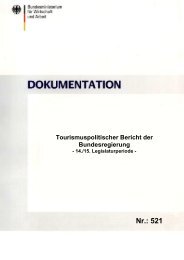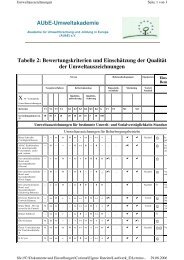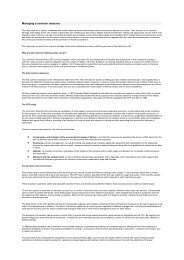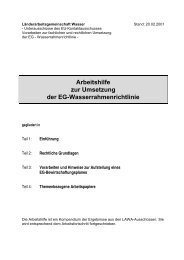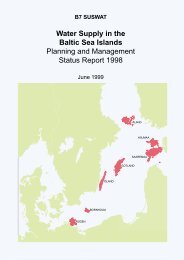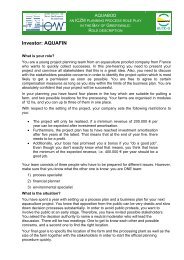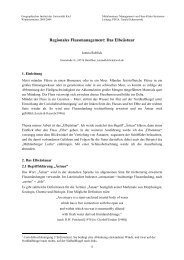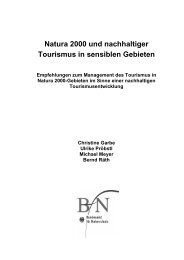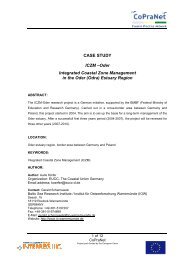The European environment - State and outlook ... - IKZM-D Lernen
The European environment - State and outlook ... - IKZM-D Lernen
The European environment - State and outlook ... - IKZM-D Lernen
You also want an ePaper? Increase the reach of your titles
YUMPU automatically turns print PDFs into web optimized ePapers that Google loves.
Executive summary<br />
offset by rising energy consumption by consumers <strong>and</strong> the<br />
service sector. More electrical appliances are being used<br />
in increasing numbers of households. Studies indicate<br />
that electrical appliances left on st<strong>and</strong>-by mode, for<br />
example, now account for 3–13 % of household electricity<br />
consumption.<br />
By 2030, the dem<strong>and</strong> for energy across Europe is expected<br />
to rise by close to 20 %, a much slower rate than foreseen<br />
for gross domestic product (GDP), but nonetheless in the<br />
wrong direction vis-à-vis the requirements to combat<br />
climate change. Cost-effective measures for improving<br />
energy efficiency remain underused. More efficient<br />
combined heat <strong>and</strong> power stations could improve energy<br />
supply efficiencies. Carbon capture <strong>and</strong> storage could<br />
serve as a transition technology. Efficiency measures for<br />
buildings, vehicles <strong>and</strong> consumer goods stimulated by<br />
market-based instruments <strong>and</strong> regulations would help<br />
reduce dem<strong>and</strong>.<br />
In the medium term, sustained investment in renewable<br />
energies, energy efficiency <strong>and</strong> in hydrogen as an energy<br />
source could help reduce <strong>European</strong> dependency on fossil<br />
fuels. <strong>The</strong> latter would especially help the transport sector<br />
which is the fastest growing contributor to Europe's<br />
growing energy dem<strong>and</strong> <strong>and</strong> CO 2<br />
emissions. Worryingly,<br />
this trend is expected to continue in coming decades. Air<br />
travel in particular is expected to double its share of overall<br />
transport between 2000 <strong>and</strong> 2030.<br />
<strong>The</strong> EU has shown committed leadership by setting<br />
ambitious targets <strong>and</strong> goals for greenhouse gas reductions.<br />
It has also accepted that inaction poses too great a risk.<br />
Shifting to low-carbon energy sources, as suggested by EEA<br />
scenarios, will entail higher energy bills for the consumer.<br />
But doing nothing also has a cost, as several studies looking<br />
at this issue are beginning to show. One suggests that the<br />
'social costs of carbon' — the costs to global society of every<br />
tonne of carbon emitted to the atmosphere — are around<br />
EUR 60 per tonne. Other studies suggest much higher costs.<br />
Different estimates depend on how long-term impacts on<br />
climate, agriculture, air quality, pests, water supplies <strong>and</strong><br />
diseases are given a monetary value.<br />
<strong>The</strong>se costs can be put into perspective when considering<br />
that greenhouse gas emissions in the EU-25 range<br />
from 5 tonnes to 25 tonnes of carbon per person<br />
depending on which country you live in (equivalent<br />
to EUR 300/person to EUR 1500/person in social<br />
costs). This compares with the estimated additional<br />
costs of EUR 45/person in 2030 for a low carbon<br />
economy: the latter is considerably less expensive.<br />
We are healthier, but exposure to<br />
pollutants remain<br />
Europe has made great strides in reducing many<br />
forms of air pollution. In particular, it has eliminated<br />
smog in many areas <strong>and</strong> reduced acid rain. However,<br />
high concentrations of fine particulates, <strong>and</strong> groundlevel<br />
ozone in particular, are still causing health<br />
problems in many cities <strong>and</strong> surrounding areas.<br />
Ground-level ozone is also damaging for ecosystem<br />
health <strong>and</strong> for crops across large areas of rural<br />
Europe.<br />
Despite reductions in emissions, concentrations of<br />
these pollutants remain high, often above existing<br />
targets. Exposure to concentrations leads to reduced<br />
life expectancy <strong>and</strong> causes premature death <strong>and</strong><br />
widespread aggravation to health. <strong>The</strong> increasing<br />
volume of transport, 30 % for freight <strong>and</strong> 20 % for<br />
passengers over the past 10 years, has meant that<br />
significant technological improvements have not<br />
resulted in much overall reduction in emissions.<br />
Europe loses 200 million working days a year to<br />
air pollution-related illness. Moreover, the OECD<br />
estimates that 6.4 % of deaths <strong>and</strong> illnesses in young<br />
<strong>European</strong> children are caused by outdoor pollution.<br />
This figure is disproportionately more in the new EU<br />
Member <strong>State</strong>s. Analysis underpinning the <strong>The</strong>matic<br />
Strategy for air pollution published in September<br />
2005 has shown that substantial impacts on people's<br />
health <strong>and</strong> ecosystems will persist even with full<br />
implementation of existing legislation.<br />
Improvements in transport technologies, from hybrids<br />
to hydrogen fuelled vehicles, all have their parts to<br />
play in reducing the exposure. So, too, does urban<br />
planning, which could offer integrated transport<br />
18<br />
<strong>The</strong> <strong>European</strong> <strong>environment</strong> | <strong>State</strong> <strong>and</strong> <strong>outlook</strong> 2005



